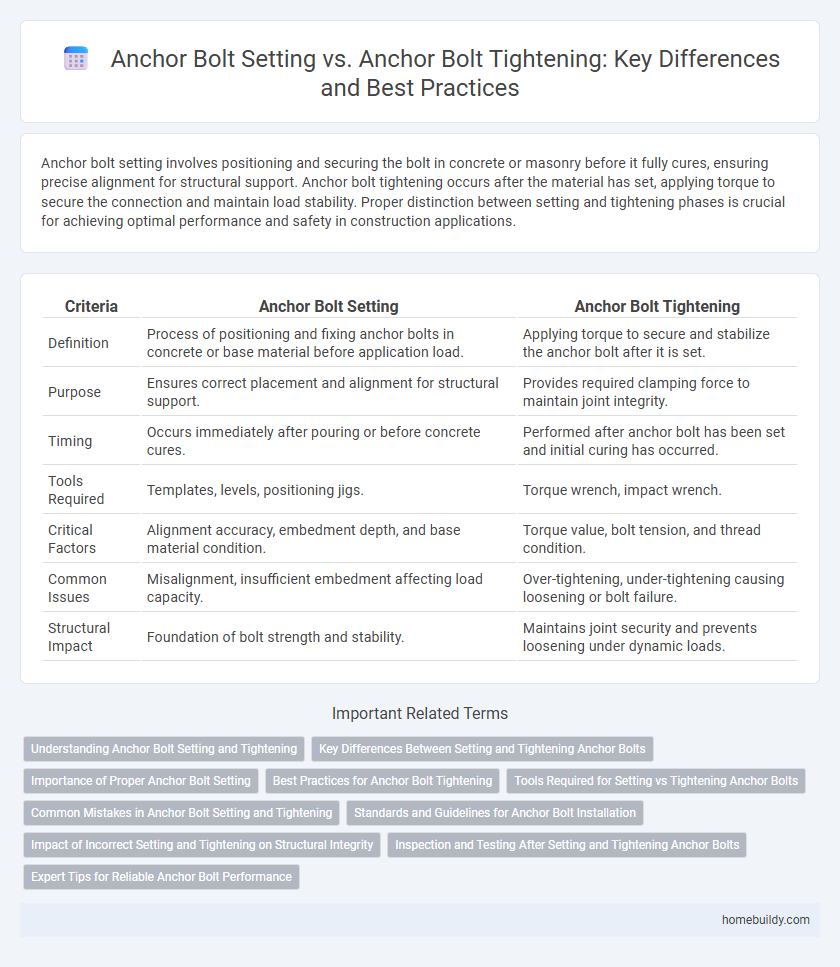Anchor bolt setting involves positioning and securing the bolt in concrete or masonry before it fully cures, ensuring precise alignment for structural support. Anchor bolt tightening occurs after the material has set, applying torque to secure the connection and maintain load stability. Proper distinction between setting and tightening phases is crucial for achieving optimal performance and safety in construction applications.
Table of Comparison
| Criteria | Anchor Bolt Setting | Anchor Bolt Tightening |
|---|---|---|
| Definition | Process of positioning and fixing anchor bolts in concrete or base material before application load. | Applying torque to secure and stabilize the anchor bolt after it is set. |
| Purpose | Ensures correct placement and alignment for structural support. | Provides required clamping force to maintain joint integrity. |
| Timing | Occurs immediately after pouring or before concrete cures. | Performed after anchor bolt has been set and initial curing has occurred. |
| Tools Required | Templates, levels, positioning jigs. | Torque wrench, impact wrench. |
| Critical Factors | Alignment accuracy, embedment depth, and base material condition. | Torque value, bolt tension, and thread condition. |
| Common Issues | Misalignment, insufficient embedment affecting load capacity. | Over-tightening, under-tightening causing loosening or bolt failure. |
| Structural Impact | Foundation of bolt strength and stability. | Maintains joint security and prevents loosening under dynamic loads. |
Understanding Anchor Bolt Setting and Tightening
Anchor bolt setting involves accurately positioning and securing the anchor bolt in concrete before it cures to ensure proper alignment and load-bearing capacity. Anchor bolt tightening occurs after initial setting, applying precise torque to achieve the designed clamping force, maintaining structural integrity without damaging the bolt or base material. Proper understanding of both processes is essential for ensuring long-lasting stability and safety in construction applications.
Key Differences Between Setting and Tightening Anchor Bolts
Anchor bolt setting involves positioning and embedding the bolt into concrete or a foundation to ensure proper alignment and secure placement before curing. Anchor bolt tightening refers to applying torque to the bolt's nut after the concrete has cured, generating the necessary clamping force to hold structural elements firmly in place. Key differences lie in timing--setting occurs during installation while tightening is performed post-curing--and purpose, with setting focused on accurate placement and tightening aimed at achieving structural stability.
Importance of Proper Anchor Bolt Setting
Proper anchor bolt setting ensures accurate alignment and positioning, which is critical for structural stability and load distribution. Incorrect setting can lead to misalignment, causing excessive stress and potential failure during tightening and service life. Precision in anchor bolt placement enhances the effectiveness of subsequent tightening, maintaining safety and integrity in construction projects.
Best Practices for Anchor Bolt Tightening
Anchor bolt tightening requires precise torque application to ensure structural integrity and avoid bolt damage, with torque values often specified by engineering standards such as ACI or ASTM. Best practices include using calibrated torque wrenches, tightening bolts in a star pattern to distribute load evenly, and verifying tension with turn-of-nut or direct tension indicators. Proper sequence and torque control during anchor bolt tightening prevent slippage and maintain safety in construction and machinery installations.
Tools Required for Setting vs Tightening Anchor Bolts
Anchor bolt setting primarily requires tools such as a drill for hole creation, a hammer or mallet for positioning, and a level for alignment to ensure accurate placement. Tightening anchor bolts involves using wrenches or torque guns to apply precise torque values, guaranteeing secure fastening and load distribution. Proper selection of these tools is essential for effective installation and long-term structural integrity.
Common Mistakes in Anchor Bolt Setting and Tightening
Common mistakes in anchor bolt setting include improper embedment depth, misalignment with the structural base, and failure to use appropriate templates or fixtures, which compromise load transfer and structural integrity. During anchor bolt tightening, over-torquing or uneven tightening can lead to bolt damage or insufficient clamping force, risking structural looseness or failure. Ensuring precise positioning during setting and controlled torque application using calibrated tools are critical to avoid these frequent errors.
Standards and Guidelines for Anchor Bolt Installation
Anchor bolt setting and anchor bolt tightening are critical stages governed by standards such as ACI 355.2 and ASTM F3125 to ensure structural safety and performance. Proper setting involves precise placement and alignment according to engineered specifications, while tightening must meet prescribed torque values to achieve required tension and prevent slippage. Compliance with these guidelines ensures the anchor bolts maintain their load-bearing capacity under seismic, wind, and dynamic forces.
Impact of Incorrect Setting and Tightening on Structural Integrity
Incorrect setting of anchor bolts can lead to misalignment, reduced load capacity, and compromised structural stability, increasing the risk of structural failure under stress. Inadequate tightening results in insufficient clamping force, which can cause bolt slippage, fatigue, and eventual loosening, deteriorating the connection strength. Both errors significantly undermine the overall structural integrity, making precise installation and torque control critical for safety and durability.
Inspection and Testing After Setting and Tightening Anchor Bolts
Inspection and testing after setting anchor bolts ensure correct embedment depth and alignment, preventing structural misfits. Following tightening, torque verification and tension tests confirm proper clamping force and bolt preload, reducing the risk of loosening under load. Routine non-destructive evaluation methods, such as ultrasonic or magnetic particle inspection, detect potential flaws or fatigue in both phases to maintain structural integrity.
Expert Tips for Reliable Anchor Bolt Performance
Anchor bolt setting requires precise alignment and proper embedment depth to ensure structural stability, while anchor bolt tightening focuses on achieving the optimal torque without over-stressing the bolt. Experts recommend using calibrated torque wrenches and adhering to manufacturer specifications during tightening to prevent loosening or fatigue failure. Consistent inspection and use of high-quality materials further enhance reliable anchor bolt performance in critical applications.
Anchor bolt setting vs Anchor bolt tightening Infographic

 homebuildy.com
homebuildy.com